
Ajmerpronounced [ədʒmeːr](listen) is one of the major and oldest cities in the Indian state of Rajasthan and the centre of the eponymous Ajmer District. It is located at the centre of Rajasthan. It is also known as heart of Rajasthan. The city was established as "Ajayameru" by a Chahamana ruler, either Ajayaraja I or Ajayaraja II, and served as their capital until the 12th century CE.
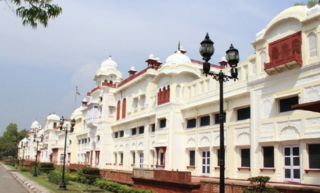
Patiala is a city in southeastern Punjab, northwestern India. It is the fourth largest city in the state and is the administrative capital of Patiala district. Patiala is located around the Qila Mubarak constructed by the Sidhu Jat Sikh chieftain Ala Singh, who founded the royal dynasty of Patiala State in 1763, and after whom the city is named.
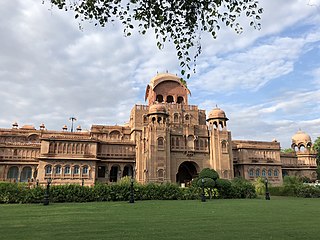
Bikaner is a city in the northwest of the state of Rajasthan, India. It is located 330 kilometres (205 mi) northwest of the state capital, Jaipur. Bikaner city is the administrative headquarters of Bikaner District and Bikaner division. The Collector and District Magistrate of Bikaner is Sh. Bhagwati Prasad Kalal, and the Superintendent of Police is Tejaswini Gautam IPS.

The First Anglo-Sikh War was fought between the Sikh Empire and the British East India Company in 1845 and 1846 in and around the Ferozepur district of Punjab. It resulted in defeat and partial subjugation of the Sikh empire and cession of Jammu and Kashmir as a separate princely state under British suzerainty.
Ratangarh is a town and Tehsil of the Churu district in Rajasthan, India. Ratangarh was previously called Kolasar. It is famous for grand havelis (mansions) with frescoes, which is an architectural specialty of the Shekhawati region. Ratangarh is also famous for its handicraft work.

Sirsa district is the largest district of Haryana state by Area. Sirsa is the district headquarters. It is located on National Highway 9 and 250 kilometres (160 mi) from the capital Delhi. On September 1, 1975, Sirsa became a district by taking Sirsa and Dabwali tahsils from Hisar District. There are a total of 323 villages in Sirsa district. Ganga and Choutala are only two largest Villages of Sirsa having area more than 5000 hectares. About 75% of the population lives in the rural areas. Sirsa gets an annual rainfall of about 26 cm. The area under cultivation is 3,88,000 hectares out of which 3,06,000 is irrigated. The district excels in the production of Cotton, Rice, and citrus fruit.
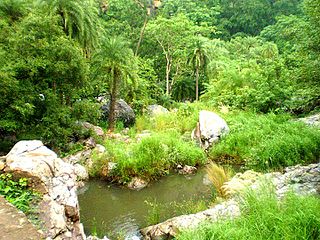
Sariska Tiger Reserve is a tiger reserve in Alwar district, Rajasthan, India. It stretches over an area of 881 km2 (340 sq mi) comprising scrub-thorn arid forests, dry deciduous forests, grasslands, and rocky hills. This area was a hunting preserve of the Alwar state and was declared a wildlife sanctuary in 1958. It was given the status of a tiger reserve making it a part of India's Project Tiger in 1978. The wildlife sanctuary was declared a national park in 1982, with a total area of about 273.8 km2 (105.7 sq mi). It is the first reserve in the world with successfully relocated tigers. It is an important biodiversity area in the Northern Aravalli leopard and wildlife corridor.
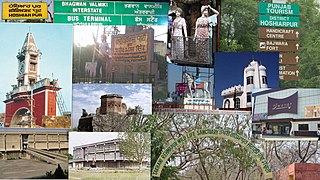
Hoshiarpur is a city and a municipal corporation in Hoshiarpur district in the Doaba region of the Indian state of Punjab. It was founded, according to tradition, during the early part of the fourteenth century. In 1809, it was occupied by the forces of Maharaja Karanvir Singh and was united into the greater state of Punjab in 1849.
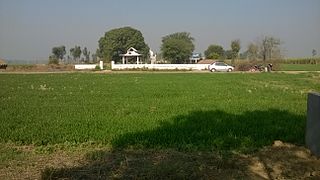
Hoshiarpur district is a district of Punjab state in northern India. Hoshiarpur, one of the oldest districts of Punjab, is located in the North-east part of the Punjab state and shares common boundaries with Gurdaspur district in the north-west, Jalandhar district and Kapurthala district in south-west, Kangra district and Una district of Himachal Pradesh in the north-east. Hoshiarpur district comprises 4 sub-divisions, 10 community development blocks, 9 urban local bodies and 1417 villages. The district has an area of 3365 km2. and a population of 1,586,625 persons as per census 2011.

Sri Ganganagar is a planned city and the northernmost city of the Indian state of Rajasthan, near the international border of India and Pakistan. It is the administrative headquarters of Sri Ganganagar district. It is named after Maharaja Shri Ganga Singh Bahadur, Maharaja of Bikaner. The city is also known as the "Food Basket of Rajasthan".
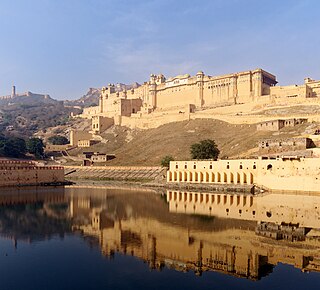
Amer Fort or Amber Fort is a fort located in Amer, Rajasthan, India. Amer is a town with an area of 4 square kilometres (1.5 sq mi) located 11 kilometres (6.8 mi) from Jaipur, the capital of Rajasthan. Amber city and Amber fort were founded by ruler Alan Singh Chanda of Chanda dynasty of Meenas. Located high on a hill, it is the principal tourist attraction in Jaipur. Amer Fort is known for its artistic style elements. With its large ramparts and series of gates and cobbled paths, the fort overlooks Maota Lake, which is the main source of water for the Amer Palace.

Kangra is a city and a municipal council in Kangra district in the Indian state of Himachal Pradesh. It is also known as Nagarkot.

Loharu is a city, municipal committee and assembly constituency, near Bhiwani City in the Bhiwani district of the Indian state of Haryana. It is the administrative headquarters of one of the four administrative sub-divisions of the district and covers 119 villages. It is also a railway junction station.
Charkhi Dadri is a city and headquarters of Charkhi Dadri district in the state of Haryana located in southern Haryana, India, about 90 km from the national capital Delhi. The town was made by joining the villages of Charkhi and Dadri after urban development. Charkhi Dadri is on NH 148B between Narnaul to Bathinda and NH 348B between Meerut to Pilani segment passing through the city.
Mahendragarh is a city and a municipal committee in Mahendragarh district in the Indian state of Haryana. It is 100 kilometres (62 mi) from Gurgaon and comes under National Capital Region (India).

The Battle of Saragarhi was a last-stand battle fought before the Tirah Campaign between the British Raj and Afghan tribesmen. On 12 September 1897, an estimated 12,000 – 24,000 Orakzai and Afridi tribesmen were seen near Gogra, at Samana Suk, and around Saragarhi, cutting off Fort Gulistan from Fort Lockhart. The Afghans attacked the outpost of Saragarhi where thousands of them swarmed and surrounded the fort, preparing to assault it. Led by Havildar Ishar Singh, the 21 soldiers in the fort—all of whom were Sikhs—refused to surrender and were wiped out in a last stand. The post was recaptured two days later by another British Indian contingent.
Auwa is a village in the Marwar Junction tehsil of Pali district in Rajasthan, India. The village is situated 13 km from Marwar Junction railway station.
Jiliya is a place in Nagaur District of Rajasthan, India. It was a Princely Thikana in British India. It is developing as a tourist spot to explore the natural scenic beauty of Rajasthan. The majority of the population is involved in agricultural and trade activities. NGOs such as Sankalp Volunteer Society are active in this region of Rajasthan and foreigners participate in the "Jiliya Project" which is one of the five projects of this NGO in India.
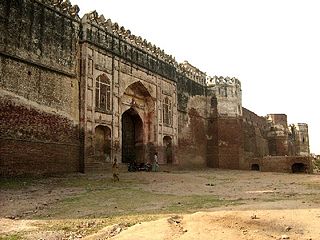
Sheikhupura Fort is a Mughal-era fort built in 1607 near the city of Sheikhupura in Punjab, Although, there is no conclusive evidence supporting this, the Tuzk-e-Jahangiri mentions that the Emperor assigned the job of constructing the Fort to Sikandar Moeen on his hunting trip to Hiran Minar in 1607AD. It was built during the reign of Emperor Jahangir. The fort was drastically altered during the Sikh-era, with numerous buildings constructed - some with exquisite Sikh-era frescoes. In 1808, the fort was conquered by the six-year-old of Maharaja Ranjit Singh, Prince Kharak Singh. Ranjit Singh granted this fort as “Jagir”, in 1811 to his wife and the prince's mother, Maharani Datar Kaur who had a considerable role in its rehabilitation and lived in it to her last day.

Kaulas Fort is a historic fort in western Telangana in India. It was constructed by Rashtrakutas in the 9th century CE. It later came under the rule of Chalukyas of Badami, the Kakatiyas, Musunuri Nayaks, Bahmani Sultanate, Qutub Shahis, Mughals, Marathas and, finally, the Asaf Jahi rulers of the Hyderabad State. It is in the Kamareddy district, near the trijunction of Telangana, Karnataka and Maharashtra states. It has historically served as a strategic outpost contested by many kingdoms.
















